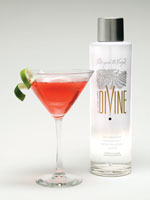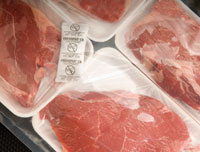

Attractive bottles and a marketing hook are critical when charging $30-plus for a bottle of vodka. Divine bills itself as “an estate vodka,” while p.i.n.k. emphasizes the infusion of caffeine and guarana. Source: Entente Spirits LLC and p.i.n.k. Spirits Co.
Now, the fallen are mighty.
Grey Goose got the super-premium vodka ball rolling six years ago, and the field of $30-plus brands gets more crowded by the day. Quite an accomplishment for a product that is, by definition, a neutral spirit. The standard of identity promulgated by the Bureau of Alcohol, Tobacco and Firearms in 1949 was amended a decade ago to allow up to 1,000 ppm of citric acid, but the fundamental requirement that vodka be “without distinctive character, aroma or taste” remains in place.
All manner of formulation twists are being tried, and eye-catching bottles are a must. “Ninety-nine percent of the time, the package is going to be the majority of your cost,” bluntly states David Otis, a principal in Chicago’s Entente Spirits LLC and creator of Divine vodka.
Divine is one of the boutique brands scrambling for retail space. Distilled 27 times from grapes grown by a southwestern Michigan winery, Divine relies on acid-etched glass and a cylindrical shape to suggest the Round Barn Farm where production takes place. The brand strives to duplicate the small-batch success of Ketel One. In fact, Round Barn uses the same type of copper-bottomed European still as Ketel One, Otis proudly claims.
The bottle relies on imported glass, ceramic and soy ink to make a shelf statement, though Otis isn’t sure if it’s sufficiently dramatic. One look at any well-stocked retailer’s vodka section shows why. Acid-etched glass with a clear window to view a Rembrandt or other images on the bottle’s opposite wall are popular, and glass bugles and other exotic shapes vie for attention.
Red Bull meets Absolut in p.i.n.k., a vodka infused with caffeine and guarana and packaged in another cylindrical bottle. The spirit jump-starts both young Millennials and Baby Boomers with “the equivalent of half a cup of coffee in a drink,” according to David Mandell, president and CEO of New York-based p.i.n.k. Spirits Co. Young adults grew up with energy drinks, and older ones are “trying to make a cocktail that doesn’t make them tired.” The $40-a-bottle beverage debuted two years ago and recently expanded into tequila and other hot spirits categories.
Pink organic inks give Mandell’s frosted bottles a muted glow. “There’s a lot of clutter, and you have to have something unique,” he shrugs.
For the company it keeps, p.i.n.k.’s five-time distilling process is modest, though it undoubtedly delivers the kind of “finish” vodka snobs crave. But the real key to prying a super-premium price from drinkers’ wallets is the aspirational aspect: “You might not be able to afford a BMW,” says Mandell, “but you can drive one for the day.”

Nothing says fresh like shrink film over a simple foam tray, but that isn’t an option without an effective oxygen absorber in the mother bag if the meat is being shipped from a fabrication plan hundreds of miles away. Source: Multisorb Inc.
Case-ready reconsiders low-oxygen packaging
Oxygen absorbers have been keeping shelf-stable foods fresh for decades, but getting the iron powder inside those sachets to oxidize in a refrigerated environment was asking too much-until recently.Multisorb Technologies used the Worldwide Food Expo stage last fall to launch Fresh Pax CR (case-ready), an oxygen absorber that performs in a cold environment to remove the 0.5-2% of oxygen remaining in a hermetically sealed master bag after it has been flushed with nitrogen and carbon dioxide. “It’s an extremely rapid oxygen absorber that operates at temperatures below 28°-30° F,” says Tom H. Powers, director of research & marketing at Buffalo, NY-based Multisorb. By reducing the remaining oxygen to almost zero within 48 hours, the sachets arrest spoilage for up to 21 days.
Based on initial reaction, Multisorb has expanded its case-ready program to include an automatic dispensing system that holds the packets in a nitrogen atmosphere until discharged into a mother bag. A pink pill is placed with the sachet in the bag. “If the package has been compromised, the pill will turn blue,” explains Powers.
High-oxygen modified atmosphere packaging has dominated the case-ready scene, in part because it eliminates the need for special secondary packaging and because it costs less overall. But while beef packed in hi-ox MAP can keep its color for two weeks or longer, the practical life of the product is no more than eight days, Powers says. Off-flavors lead to lost sales, and those business costs may exceed the estimated 15% of out-of-code meat that is returned to suppliers.
During pilot tests, sachets were tossed by hand into master bags, and some processors continue to rely on manual delivery. But they dissipate themselves within minutes after removal from an inert environment, which is why the automatic dispenser was engineered.
For more information:
Tom H. Powers, 716-316-4315,
tpowers@multisorb.com

Monolayer PET with an embedded oxygen scavenger helped ConAgra’s Hunt’s ketchup win the top sustainable packaging award at this year’s Institute of Packaging Professionals’ Ameristar Awards competition. Source: Constar International Inc.
Plastic's newest glass assault
When ConAgra Inc. collects a sustainable packaging award in May from the Institute of Packaging Professionals for the Hunt’s ketchup container, developers of the lightweight PET will be saying, “One category down, many more to come.”Chemists at the Alsip, IL R&D center of Constar International Inc. created the oxygen-scavenging molecule incorporated in the preforms of Hunt’s monolayer bottles. The proprietary molecule, “added to the PET stream with off-the-shelf dosing equipment at the injection molder,” works with a catalyst to react with oxygen atoms at room temperature, according to Matt Dauzvardis, senior director-global technology & materials development.
By blending the chemical with the PET when the preform is made, co-injection for multi-layer containers is eliminated, Dauzvardis says. Lightweight monolayer construction also eliminates the haze created when two different polymers are integrated, and a higher gloss is achieved than with regular PET.
The clarity issue thwarted earlier technological solutions to the oxygen issue with PET. The Sidel Group won FDA approval in 2000 for an amorphous carbon treatment on food contact surfaces, setting the stage for monolayer beer bottles. But despite some pilots with European brews, Sidel’s technology never cracked the American beer market-and neither will Constar’s DiamondClear, cautions Dauzvardis. While the material is effective in scavenging oxygen, “carbon dioxide loss is a problem.”
For more information:
Scott Pleune, Constar International Inc., 215-552-3705,
spleune@constar.net